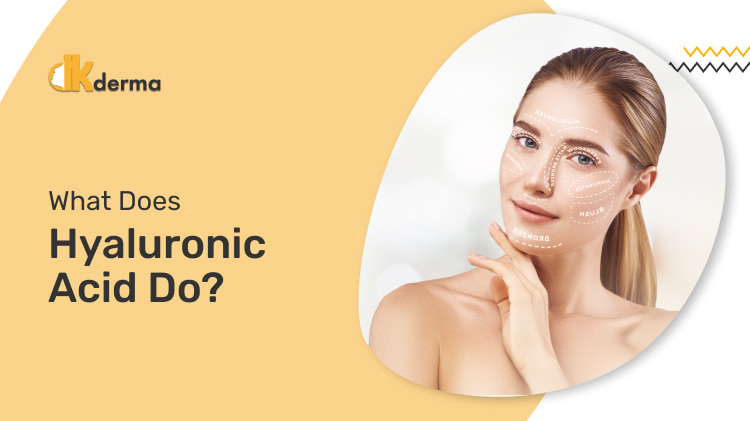Email or phone us with any questions or suggestions:
[email protected]

In the recent few years, everyone has been literarily obsessed with hyaluronic acid. Any cosmetic product for the skin you can find on the shelves of cosmetic stores mandatory contains hyaluronic acid. Many regard it as a perfect and universal ingredient for all skin types, but in reality, how many of us understand what hyaluronic acid is, how it works, and why we need it. Let’s figure out all this obsession with hyaluronic acid products and procedures!
Perfect moisturizer, an elixir of youth and beauty … Are these mere poetic epithets or a real description of a polysaccharide? Scientists talk about it in a more mundane and rational way since it is excellently studied as an important substance naturally present in any living organism, including the human body.
Hyaluronic acid (also called hyaluronate) is a biopolymer that is synthesized in the body by proteins, and itself becomes part of complex proteins. As an irreplaceable compound, it is found in joints and connective tissue, body fluids, the vitreous substance of the eyes, skin, and nerve tissues. Hyaluronic acid has only one minus: over time, its number decreases. Then it’s time to think about hyaluronic acid supplements and cosmetics.
Hyaluronic acid was first isolated by biochemists Karl Meyer and John Palmer. It happened in 1934, at the same time, the researchers determined what it consists of, and a little later, they gave it a “name”. “Hyaluronic” refers to the Greek “hyalos”, which can be translated as “glass”.
It was only in the 70s that the progenitor of hyaluronic acid appeared as an innovative substance used in ophthalmic operations. Now the purest product of high quality is obtained by fermentation of cereals with the help of microorganisms capable of synthesizing acid.
Much later, scientists studied how hyaluronate in liquid form affected the skin of the face and came to the conclusion that it has a great future in cosmetology. As we can see, they were not mistaken! Modern researchers have proven that natural hyaluronic acid is essential for human skin. Only it is able to penetrate into tissues without rejection and adverse effects, attracting and binding water molecules.

We can endlessly list what hyaluronic acid does to the skin of the face and how it is useful, but let’s focus on the main benefits of this substance.
Since hyaluronic acid acts on the skin in a targeted and effective manner, it would be logical to assume that it has some limitations.
According to dermatologists, when one completely safe ingredient in cosmetics and medical products appears, the world will turn upside down. And yet, pure hyaluronic acid of natural origin is practically unable to harm the skin of the face.
There are only three exceptions:
Actually, there are no strict age restrictions. Young skin, as a rule, does not need hyaluronate, but it is sometimes found in the range of cosmetics for teenagers. “Adult” cosmetics with hyaluronic acid are recommended by manufacturers only for adult men and women.
And if yesterday’s facial fine lines and wrinkles already visually resemble, rather, folds, you definitely cannot do without a skin care routine with this powerful anti-aging compound.
As we already know, in cosmetology, hyaluronic acid is applied externally in a concentration of up to 1%, and this number applies to both high molecular weight and low molecular weight acid. They are united by their focus on moisturizing (skin nutrition is not part of the function of hyaluronic acid), but their effect is noticeably different. Let’s take a closer look at the difference between the two types of hyaluronate.
Large molecules do not penetrate deeper than the epidermis, which makes one think that this type of acid is completely useless. Cosmetologists and dermatologists have a different opinion, appreciating the ability of hyaluronate to be distributed over the skin, duplicating and strengthening the protective skin barrier.
With this feature, the high-molecular-weight acid resembles oils that also do not pass beyond the epidermis, incorporating into its hydrolipid layer and blocking moisture evaporation. With one amendment – hyaluronate, unlike most oils, does not provoke the appearance of comedones on problem skin. In addition, it is able to retain components with a significantly lower molecular weight, which are released and begin their work deeper than the epidermis.
Otherwise, hydrolyzed hyaluronate interacts with the skin of the face: it penetrates deep into the dermis and remains there, becoming a magnet for moisture in the skin cells. The result of its work is hydrated skin at all levels and the prevention of age-related changes.
The combination of high-molecular and low-molecular hyaluronic acid is recognized by dermatologists as the most effective: in this way, the two substances simultaneously solve skin problems both on its surface and in deep layers, helping each other.
The chemical characteristics of hyaluronate allow it to be added to liquid, gel-like and thicker treatments. What is more convenient and efficient at home?
How does the serum work on the face? In the so-called serums, the active compounds are given in high concentration without unnecessary additives and, as a rule, without the fat fraction. Because of this feature, applying hyaluronic acid serum should be one of the 1st steps of the skincare and then a cream that will protect the active substances of the serum from evaporation. Beauty bloggers note the high effectiveness of serums with hyaluronic acid when applied to damp skin – immediately after washing or after toning.
These products are suitable for daily beauty routine and applied to dry, cleansed skin on its own or after serum. You can combine hyaluronic acid serum and cream for extremely dry or dehydrated skin.
Indispensable participants in the weekly routine, complementing the usual care and having a pronounced prolonged effect. Hyaluronic masks can also be used as an express remedy when a “dose” of hyaluronate is needed now, immediately. This happens, for example, after long exposure to the sun. In any unpleasant situation that requires a lightning-fast reaction, a moisturizing mask will save dry skin. Cosmetologists recommend using it a couple of times a week – and after any negative influences from the outside, be it a blizzard, seawater, or the sun.
The most comfortable texture for oily, dehydrated, or problem skin. These products help out in the summer heat when the usual cream causes discomfort. Hyaluronic acid gels and emulsions can be used instead of creams, as their composition contains everything you need to maintain the beauty of skin prone to increased sebum production, severe dryness, or allergies.
A few simple rules will make your hyaluronic acid routine even more effective.
Hyaluronic acid is an essential substance that naturally occurs in human tissues. It is not strange hyaluronic acid supplements and skincare products are so popular for a beautiful, youthful appearance. Creams, serums, and masks containing hyaluronic acid are a real rescue for exhausted and dry skin. Attracting water molecules, hyaluronic acid helps to retain moisture inside the dermal tissues for firm, smooth, radiant, healthy, and hydrated skin. It also has an almost miracle rejuvenating effect when it comes to eliminating skin wrinkles and fine lines, improving skin elasticity, and evening the complexion. For those who feel daily skincare is not enough, cosmetology offers hyaluronic acid injections – one of the greatest recent inventions in the sphere of beauty. In Dkdermal you can order any type of dermal fillers injections online.
I hope, this article was interesting and useful for you, and you will consult with your cosmetologist on how to implement and use hyaluronic acid in your daily skincare routine for even more beautiful and youthful skin.